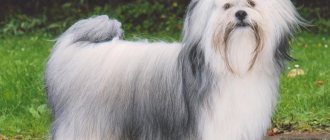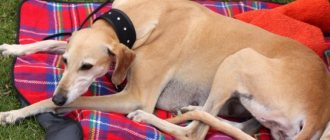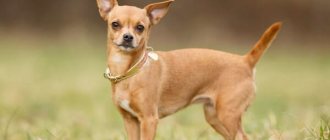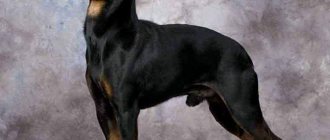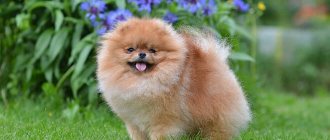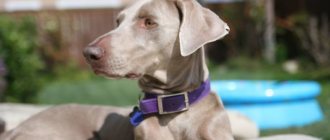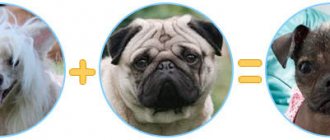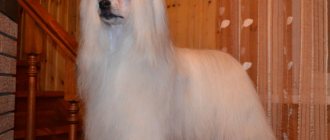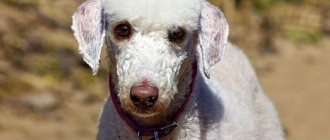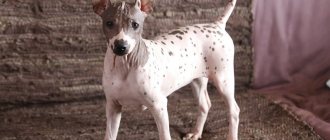Photo: Keeshond
Keeshond is the Dutch name for the German Wolfspitz. This breed appeared a long time ago from an ancient peat dog that lived during the Stone Age. Keeshonds are the tallest among all Spitz dogs. They are distinguished by the peculiar wolf color of their coat, liveliness of character, friendliness and extraordinary mental abilities. Germany became the first country where the Wolfspitz was recognized as a separate breed. These dogs were used to guard houses and livestock, and they were also often used for hunting.
- Country of origin – Germany
- Height – 49±6 cm
- Weight – 25-30 kg, depending on height
- FCI Classification: Group 5, Section 4 No. 97 (1957)
- English name : Keeshond
- Other names: Wolfspitz
History of the breed
The German Wolfspitz is considered one of the oldest dog breeds known in Europe. It is recognized as a separate species in Germany. Another name for the breed, Keeshond, was given in Holland.
These dogs were bred to guard barges. That's why they were also called barge dogs. Sometimes this explains their partiality to bathing.
Wolfspitz breeding began in the 16th century. Representatives of the Spitz family spread across different regions of Europe.
The Wolfspitz appeared in Russia in the last decade of the 20th century. The wolf-colored Keeshond is known as a guard dog and was bred to guard homes, herds, and fishing boats.
The Keeshond has a distinct wolf coloration.
For a long time, dog breeders showed no interest in the ancestors of the modern Wolfspitz. Characteristics such as cute appearance, watchdog qualities, easy trainability and good health have made them versatile.
Over the past centuries, the description of the breed and its appearance have remained virtually unchanged. The Wolfspitz has physiological similarities to the Pomeranian and German Spitz .
Important! The Keeshond is now considered an inbreed type of Wolfspitz. These dogs have the same origin. The German Wolfspitz is larger and more active than the Keeshond type.
Description of the breed
Keeshonds have a harmonious body build, and their height can reach up to 55 cm and weigh up to 30 kg. Like all Spitz dogs, they have an upright coat that is longer on the neck, hind legs and tail. The hair on the head is much shorter. A fox face with dark circular spots around almond-shaped eyes is crowned with neat triangular ears.
The color of the dogs of the described breed is wolf, which is reflected in the name of the breed. Black ears and the same tip of a shaggy tail are also breed characteristics. The Wolfspitz's undercoat is thick and light.
Due to the special structure of their muzzle, due to which these Spitz dogs give the impression of constantly smiling dogs, they were nicknamed the smiling Dutch.
Character of Wolfspitz
Photo: Keeshond breed
The Keeshond's temperament is lively and agile. They often demonstrate independent behavior and self-confidence; at the same time, at the same time, these qualities in dogs of the breed show increased affection for the owner. However, they are suspicious and cautious with strangers, which increases their protective qualities.
But Keeshonds are not aggressive at all, but on the contrary, they show friendliness and a desire to communicate. They may grumble and snap slightly at unfamiliar members of their tribe, but the Wolfspitz is patient and friendly with “its” pets.
The Keeshond has a special attitude towards its owner. He senses the owner’s mood immediately and does not catch the eye if his person is not interested in his beloved pet.
The training and educational process here will require firmness and patience to curb the restless baby. Thanks to their natural intelligence, Spitz dogs grasp everything on the fly, but it is difficult for them to sit still. From early puppyhood these dogs are very, very energetic. They will need long walks and significant physical activity. But as it grows up, the Wolfspitz will become increasingly calmer, while maintaining its playfulness and mobility.
Photo: Keeshond
Keeshonds are often used as search and guard dogs. They have proven themselves remarkably well in various obedience competitions. In addition, the friendliness of the Wolfspitz is used for psychotherapeutic purposes to facilitate contact with patients. Wolfspitz dogs can often be found as circus performers, where their breed qualities are demonstrated in all their glory.
Features of care
The Keeshond is known to have a tendency to overeat and become obese. You will have to strictly monitor the amount of food consumed.
The owners of these dogs claim that, despite the long hair and thick undercoat, Spitz dogs are easy to care for. You will only have to comb them out periodically, but this will not be difficult. Keeshond dogs shed frequently and profusely, so you need to be prepared for this.
Wolfspitz should be bathed as rarely as possible, only if necessary. Their thick undercoat dries poorly and takes a long time, which can cause the dog to catch a cold. If the wool is not properly dried, it can turn sour, and this is fraught with skin diseases. Many owners give their pets periodic hygienic haircuts.
Thanks to its excellent health, the life expectancy of a Volspitz is quite long - up to 17 years. This is a very good indicator for a dog. Proper and balanced nutrition will help extend your life here. It is best and more convenient to use ready-made food for this, where the portion is calculated in advance and enriched with the necessary microelements. With a natural diet, you will have to supplement your pet with vitamins under the supervision of a veterinarian. It is strictly forbidden to overfeed dogs of this breed.
Wolfspitz will need to devote a lot of time. The activity and energy of representatives of the breed should be extinguished through long walks and physical activity. In addition, this will have a positive effect on the dog’s health, and therefore on its life expectancy.
These dogs cannot be kept on a leash or in an enclosure. Their sociability, affection for the owner and his family require constant presence. Being left alone for long periods of time will definitely have a negative impact on the pet’s psyche, making it a nervous and aggressive dog.
What to name a Keeshond
The dog's name should reflect its character and individual characteristics. Often the name written down in the pedigree does not stick, but the nickname given during life next to the pet sticks forever.
- Short and sonorous names with voiced consonants may be suitable.
- For males we can recommend: Wolf, Quist, Dolph, Delvis, Bekhet, Joost, Harley, Barleus, Lucky.
- For females: Lacey, Leila, Lisa, Iowa, Laska, Nmeri, Lucy.
Psychology
In the psychological portrait of the Wolfspitz, liveliness, attentiveness, and receptivity stand out. They greet changes in the environment with loud barks.
The dog becomes strongly attached to the house and does not want to run away and live independently. She is devoted to her owners and is wary of strangers. The Wolfspitz gets along with other pets without any problems.
Wolfspitz is a sweet and friendly dog
Wolfspitz puppies are affectionate and friendly. They are not characterized by stubbornness, aggressive attacks, or whims. At the same time, puppies are very inquisitive and active, ready to explore every nook and cranny of the house.
Important! The Wolfspitz requires a lot of attention, affection and care.
Relationship with the owner
The owners have a great influence on the formation of the dog's character. If they take enough care of their pet, the puppy will grow up to be loyal and friendly.
Raising such a dog is not difficult. The German Wolfspitz is easy to train; no force is required during training.
A puppy, like an adult dog, does not require much physical activity. In addition to walks and active games, Wolfspitz love to swim and roll in the snow.
The dog subtly senses the owner’s mood. When the dog sees that there is no need for him now, he will leave without offense and go about his business.
Interesting! There is a known practice when Wolfspitz dogs participate in psychological assistance. The friendliness, enthusiasm and activity of dogs have a positive effect on the emotional state of patients with serious illnesses. Their presence eliminates stress and makes the doctor’s work easier.
It is worth noting the cleanliness of Wolfspitz dogs. They wash themselves like a cat - with their paws. A working person or a pensioner can get a puppy; he will also make good company for a family with children. Due to its size and character, it is suitable for keeping in a small apartment. Adapts well to changing external conditions and successfully withstands adverse weather conditions.
Character
Keeshonds, like all Spitz dogs, have a special cheerfulness and a large supply of energy. With external independence and independence, jealousy may appear in the character of the Wolfspitz.
The dog becomes strongly attached to its owner, and is wary and suspicious of strangers, which is due to its protective instincts. At the same time, representatives of the breed are not prone to aggression. Wolf Spitz dogs are generally friendly and love communication, and do not experience fear or embarrassment.
The Wolfspitz Keeshond shows sensitivity and understanding towards its owner. These qualities greatly facilitate the training of the animal. A developed mind allows a dog to correctly understand what is required of it. Equally, the Wolfspitz is able to respond to the owner’s busyness and will not become annoying and capricious in vain.
Application
As already mentioned, the German Wolfspitz is a versatile breed. In northern European countries, the Keeshond is known as a guard and herding dog and is used to accompany people.
Wolfspitz - guard dog and cheerful companion
When guarding livestock, a group of Wolfspitz dogs can be used. In a team, individuals work together.
How to choose a puppy
Choosing a puppy consists of two points:
- suitable nursery;
- detailed description of the breed.
Choosing a nursery
To choose a suitable nursery, you should collect as much information as possible. To do this, they visit exhibitions, go to the websites of different breeders, look at reviews and photos on forums.
When the nursery is selected, they learn about the planned litters. It is worth looking at the description of the parents, because the puppies will resemble them both in coloring and character traits.
How to choose a puppy
You need to decide what class of pet the owner needs. Whether you plan to participate in exhibitions, breed, or just need a cheerful companion for your family. Considering which puppies are two to three months old, it is impossible to predict their prospects with absolute accuracy.
When choosing a puppy, you should pay attention to its activity
As for gender, this parameter is determined only by personal preference. What to pay attention to:
- Is the puppy healthy?
- Active and cheerful?
- Does he have a good appetite?
- Is he too timid and shy?
Important! Puppies are sent to new owners at the age of two months.
Character and features
Wolfspitz (Keeshond) are energetic, confident, independent, very cheerful, kind and sociable pets.
Wolfspitz can be considered an absolutely family dog. She is completely uncharacteristic of aggression and anger. They are very loyal to their owner, love children and get along well in the same home with other pets. However, they show moderate wariness with people and animals they do not know, reacting to them by barking. Puppies of this breed are characterized by “hurricane” behavior, but with age they become calmer.
A special feature of Wolfspitz dogs is their ability to sense people’s moods very well and subtly. This feature of theirs is often used in the psychotherapeutic treatment of people: the Wolfspitz is simply present at the doctor’s appointment and, with his behavior and radiating energy, joy, has a beneficial effect on patients, helping them cope with depression.
When trained and trained, Wolfspitz dogs are distinguished by their intelligence and intelligence, so it is not difficult to teach them the necessary commands. Of course, the sooner training begins, the easier the puppy will learn commands.
However, you need to remember that Wolfspitz dogs do not like it at all if they raise their voices or use physical force in an attempt to teach them any command - such measures may make them completely lose the desire to learn. On the contrary, kind words and tone, delicious food encourage them to learn.
Combing
As you can see in the photo, Wolfspitz have long hair with a thick undercoat. During shedding, hairs that fall out of the undercoat remain in the volume of the coat.
Therefore, during this period, it is regularly combed, at least twice a week, with a furminator . Along with grooming, the dog receives a wonderful massage, which helps improve blood circulation.
Wolfspitz dogs have long, thick fur.
When shedding is over, the frequency of brushing decreases to 2-3 times a month. Too often this procedure is not carried out, since in this case it will negatively affect the performance of the coat.
Shedding takes place:
- for males – once a year;
- for bitches – twice a year;
- duration - from three weeks to a month.
At the same time, complex care is not required, which is explained by the specific structure of the coat. Hair does not fall off or tangle. dogs are not clipped , and grooming is limited to the necessary care of the coat.
Owner reviews
Olesya D.: “I live in a small house on the outskirts of the city, for the dog there is freedom in the yard. However, he does not like to walk alone. If he’s left alone, he’ll pick out the tiles from the path or dig a hole in the middle of the flowerbed.”
Igor V.: “The Keeshond is ideal for a family. Even in a small apartment he doesn’t bother anyone - he likes to sleep, for example, on the windowsill or in the bathroom.”
Rimma L.: “My case makes a formidable impression on strangers, it can bark in a loud voice. The ones he really can’t stand are drunks.”
Nutrition
For Keeshonds, a ready-made diet is preferable - high-quality industrial dry food , developed taking into account the characteristics of the breed. Feeding is carried out twice a day. Regarding the amount of food consumed, you need to follow the recommendations on the packaging.
Dogs of this breed are prone to obesity, so you need to monitor their diet
How to organize feeding
To properly approach feeding your puppy, you need to follow these tips.
- Set a clear time frame for feeding.
- After feeding, you need to remove the bowl.
- The puppy should always have a bowl of drinking water, even when the food is put away.
- In addition to the prepared diet, you should not offer your dog food from the human table.
- If puppies refuse to eat, you need to determine the reason. In some cases, this may be a symptom of a disease.
- It is important to teach your puppy to follow feeding commands. This will be required when, during a walk, the dog finds something edible in its opinion and tries to eat it. In this case, the owner will need to take the “prey” away from her.
- Prepare food and place it in a bowl only when the dog is not present.
- Feeding the pet occurs before or after the owners eat.
- Before starting feeding, puppies must develop endurance. This should be worked on regularly, from the very first days the Wolfspitz appears in the house. Prepare a bowl of food and call your pet. When the puppy comes running, do not allow him to eat immediately, but stop him by holding him by the chest. After 3-4 seconds, sit the puppy in this position, giving the command “Sit”. Command the sitting puppy “Wait” and hold it for a couple more seconds. Next, open access to the bowl and command “Eat.”
Important! To avoid obesity, it is recommended to monitor the amount of food consumed.
This article will tell you what to do if your dog eats too quickly.
Development of a home diet
It is allowed to feed the Wolfspitz homemade food. At the same time, the dog does not eat dishes from the human table, but what is prepared specifically for it.
It is worth considering that in this case it is much more difficult to make the diet balanced. To create a menu for your pet, you should consult a veterinarian or breeder.
When creating a menu, consultation is required
Maintenance and care
A place to live
Thanks to their luxurious wool, Wolfspitz dogs do not freeze even at low air temperatures. Prolonged exposure to the street has a positive effect on the quality of the coat, enhancing its growth.
Physically, they will feel good living on a personal plot without access to the house, but closeness with the owner comes first for them. Because of this, they prefer to keep Keeshonds in a house or apartment .
Feeding
Feeding rules depend on the following parameters:
- Dog age
- Type of feed
- Health status
Feeding with prepared food or food made from natural ingredients is determined by the owner himself. It is worth listening to the opinion of the breeder and drawing the best conclusion.
Conscientious sellers transfer puppies to new owners after activation, not earlier than 45 days of life . During this period they need to be fed 5 times a day .
Recommended natural diet for puppies aged 1 to 4 months :
- Fresh meat (beef, chicken, turkey) or boiled offal (tripe) - at least 100 g daily.
- A small amount of cereals (rice, buckwheat) – daily.
- Boiled chicken or quail egg – 1-2 pieces weekly
- Fermented milk products (kefir, whey, cottage cheese, fermented baked milk) – 100-200 g daily.
The meat is cut into small pieces, and the grains are boiled or steamed. If there are allergic reactions, the product that caused them is excluded from the diet.
Gradually, the number of feedings decreases, and the volume increases approximately 4 times , and by 8-9 months the daily food intake is divided into morning and evening portions.
For adults, sea fish and vegetables (zucchini, carrots) are added to the main products. When a Keeshond is small, it needs vitamin and mineral supplements prescribed by a veterinarian.
Dry food is given in accordance with the instructions. Manufacturers offer lines of food for medium-sized breeds. If a dog eats dry food, it is provided with round-the-clock access to drinking water.
Walks
It is necessary to walk a Wolfspitz at least 3-4 times a day during puppyhood. After the dog is accustomed to using the toilet outside the home, the number of walks is reduced.
The walking time is calculated depending on the condition and strength of the animal. Long walks over rough terrain, swimming in the warm season, and games with relatives are desirable. You cannot walk in a public place without a leash.
Grooming or grooming
The following tools will help you thoroughly comb the densely packed undercoat of your Keeshond:
- Rake brush
- Furminator
- Pukhoderka
By regularly brushing the armpits, areas behind the ears, mane, tail and pants, owners reduce the risk of tangles .
For exhibitions and in everyday life, Wolfspitz dogs are periodically washed using animal cosmetics, which can be done independently or in a salon.
There is no need to cut the Wolfspitz's coat ; at exhibitions, marks are reduced for excessive grooming.
If the claws do not wear off when walking, they are shortened with a nail clipper. Ears and eyes are washed if necessary.
Vaccinations
Before deciding on vaccination, consult with the breeder. He should explain when the deworming was carried out and what vaccinations the puppy received. He can also suggest a diagram of these procedures.
The first time deworming medications are given to the puppy is when he is three weeks old. This early age is explained by the fact that infection with helminths sometimes occurs in utero. This procedure is repeated at least 10-15 days later (10-15 days before vaccination).
Important! Select dewormers for small puppies with extreme caution.
Care must be taken when selecting vaccines for puppies
Vaccinations are carried out only on healthy animals. To make sure of this, the body temperature of the puppy or adult is measured two to three days before vaccination. She must:
- be within the established values (for a puppy up to 6 months – up to 39.3 degrees, for an adult dog 38.5; readings from 37.5 to 39 degrees are considered normal);
- be stable throughout the day.
Mandatory vaccines include vaccinations against:
- parvovirus enteritis;
- carnivore plague;
- parainfluenza;
- leptospirosis;
- infectious hepatitis;
- rabies.
In modern veterinary practice, monovalent and polyvalent vaccines are used.
The first are aimed at creating immunity against one disease, others - against several at once.
The latter significantly reduce the time of vaccination, therefore reducing the risk of disease. The vaccination schedule is drawn up individually by the veterinarian.
Polyvalent vaccines speed up the procedure and reduce the risk of disease
